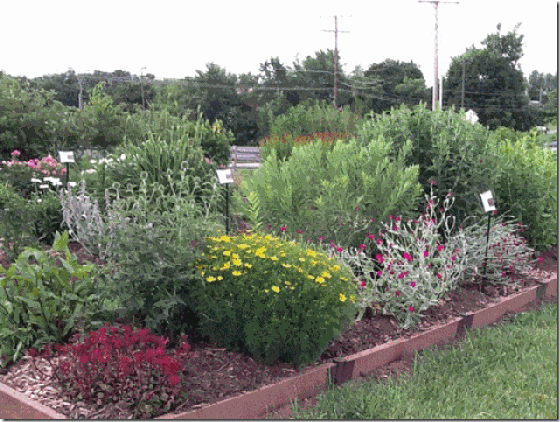
If you are a person who would like your property to look nice with minimum gardening effort, this article is for you.
How would you like to have a garden that you never have to worry about watering, even on the hottest days of summer? It's very possible, you know. There are plants that survive unaided in Death Valley, CA. You just have to know which plants to choose. We are a little luckier here in South Central, PA, where we naturally get a considerably greater
amount of rain than in many parts of the country, so our list of plants that will survive and flourish without additional water is much longer than Death Valley's!
Gardening with drought-tolerant plants, in garden lingo, is called xeriscaping. This term simply refers to gardening in ways to greatly reduce or eliminate watering.
Two other master gardeners and I have some trial gardens at the Ag Center in Gettysburg where we can experiment with plants which we never water. In addition, I have helped care for some public gardens at Lake Meade for quite a few years which never have received any supplemental watering. Each of these gardens is located in full sun, so the plants
I will be recommending are for a sunny location.

Before I begin listing plants that will perform well with no supplemental watering, let me mention a few things that will increase your chances of having a successful garden. First, adding organic material such as compost, manure, or shredded leaves to your soil is very important. It will improve the tilth of your soil, making the nutrients more
usable to your plants. It will also greatly improve drainage. Second, keeping two or three inches of mulch around your plants will help retain moisture in the soil and slow down evaporation. Third, keeping your garden free of weeds will eliminate unnecessary competition for the available water and also keep your garden looking its best. Lastly, many plants need time to
establish themselves before they can attain their true drought resistance. All plants need to be thoroughly watered at planting time, and it's a good idea to water them a few more times if the weather is especially dry until they have a chance to develop their root systems.
Some plants, however, seem downright amazing. Last spring, I dug up some Shasta Daisies ?Becky? from my own yard and took two clumps to one of the public gardens that I tend. I took along a gallon jug filled with water, dug two small holes, planted the clumps, and then divided the gallon of water between them. I never took them any more water,
ever, and they bloomed all summer right into late fall. This year their clumps are bigger and better and blooming beautifully. Unfortunately, not having to water does not mean your garden will be maintenance free. However, it does mean that you get to garden on your own time and not on demand from Mother Nature. It also means you can go away on a week's or month's
vacation and still come back to a flourishing garden even during the harshest conditions of summer.
My list of drought-tolerant plants includes many native plants. Natives are always good choices because they not only have adapted themselves to grow well in our climate, but they do the best job of providing nectar for pollinators and habitat for our local wildlife. However, my list is not restricted to natives. Many imported plants have value in
our gardens as long as they do not become invasive and crowd out native habitats. These are plants that I have found will survive and flourish well here in our area with no supplemental watering. It is in no way meant to be a complete listing. It is simply meant to supply some suggestions for getting you started toward a more environmentally- friendly garden.
The list includes Reed Grass, 'Karl Forester', Pennisetum (Fountain Grass), Perovskia (Russian Sage), Echinacea (Purple Coneflower), Eupatorium (Joe-Pye weed), any of the Sedums, Sempervivum (Hens and Chicks), and Stachys Byzantina (Lamb's Ears). Other drought-tolerant perennials include Penstemon (Beard's Tongue), Aghastache (Hyssop), Amsonia,
Asclepius Tuberosa (Butterfly Weed), Aster, Coreopsis (Tickseed), Gaura, Siberian Iris, Lychnis Coronaria (Rose Campion), Monarda (Bee Balm), Scabiosa (Pincushion flower), Day Lilies, Knock-out Roses, Lavender, and Shasta Daisies 'Becky'. Avoid Miscanthus sinensis grasses, as they tend to be invasive.
If you want to actually see these plants, visit our trial beds at the Penn State ExtensionAg Center on Old Gettysburg Rd. We are beds H1, H2, and H3. All the plants are labeled. You are free to visit at any time.
Need an idea for a no-water border? Start with the tall slender silhouette of four Karl Forester Reed grasses spaced 3 feet apart. Position 3 Russian Sage in front of the grasses. Add a row of Lamb's Ears in front of the sage. Place a triangle of three Echinacea purpurea (purple coneflowers) at each end of the arrangement. Need it larger? Add one
pink Knock-out Rose to each end beside the Echinacea, then repeat the design as many times as needed to fill the area.
Maintenance on this border will include going out in March and cutting the roses down to eighteen inches, the sage to about one foot, and the coneflowers and grasses to the ground. Sometime in July, cut the spent flowers off the Lamb's Ears. After shearing, they will fill in with fresh foliage and stay nice through the rest of the summer and well
into winter. They will be the first thing to green up and catch your eye in early spring. Add two to three inches of mulch to this border in the spring, and other than checking it for weeds now and then, it should take care of itself for the rest of the season.
Read other articles on garden and landscape design
Read other articles on gardening in drought conditions
Read other articles by Barbara Mrgich